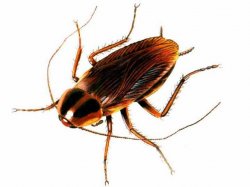Cockroaches
 Cockroaches are one of the most successful animals known in the evolution of the planet. There are more then 3,500 cockroach species existing in the world. Cockroaches are classified in the insect order Blattaria. They are separated into five families based on their shared characteristics, namely, Blattidae, Blattellidae, Cryptocercidae, Polyphagidae and Blaberidae. In general, cockroaches are tropical and live outdoors. However, 25 species are found in close association with humans. Cockroaches which are in close association with humans are of public health importance because they can mechanically transmit pathogenic organisms, and are a source of powerful allergens.
Cockroaches are one of the most successful animals known in the evolution of the planet. There are more then 3,500 cockroach species existing in the world. Cockroaches are classified in the insect order Blattaria. They are separated into five families based on their shared characteristics, namely, Blattidae, Blattellidae, Cryptocercidae, Polyphagidae and Blaberidae. In general, cockroaches are tropical and live outdoors. However, 25 species are found in close association with humans. Cockroaches which are in close association with humans are of public health importance because they can mechanically transmit pathogenic organisms, and are a source of powerful allergens.
German Cockroach
The German cockroach is worldwide in distribution. It is the most prevalent species in and around homes, apartments, supermarkets, food processing plants and restaurants. Many homes and business establishments become infested with German cockroaches when they are introduced in infested cartons, foodstuffs and other materials. The German cockroach is about 5/8 inch/16 mm in length, brown in color, with two dark longitudinal streaks on the pronotum. The male is light brown and somewhat boat-shaped. The female is slightly darker in color with a broader and rounded posterior. German cockroaches breed throughout the year indoors, yet favors a humid environment and an average temperature of about 70 degrees F/21 degrees C. The German cockroach produces more eggs per capsule then other pest cockroach species. In addition their young also complete their growth in a shorter period of time. Female German cockroaches carry their egg capsules until they are ready to hatch. The number of eggs in an egg capsule is generally 30 - 40.
Brown-Banded Cockroach
The brown-banded cockroach commonly hides in cupboards, pantries, closet shelves, behind pictures and picture frames, and other areas throughout the home and prefer high locations. The brown-banded cockroach is similar to the German cockroach in some respects but may be distinguished from it by the following general characteristics:
- The brown-banded cockroach lacks the two dark stripes on the thorax found on the German cockroach.
- The wings are twice-banded with brownish yellow stripes.
- The egg capsules are smaller then the German cockroach, being about 3/16 inches and having about half as many eggs.
Brown-banded cockroaches are active and will fly readily when disturbed. The egg capsule of the brown-banded cockroach is yellowish or reddish brown in color and is 3/16 inches in length. The female carries the egg capsule for 24 to 36 hours and then attaches it to some object. There may be up to 18 eggs in each egg capsule.
Oriental Cockroach
Like other cockroach species, Oriental cockroaches undergo a gradual metamorphosis with three distinct stages, including egg, nymph and adult. The female Oriental cockroach produces an egg capsule which is blackish-brown in color. About 16 eggs are laid in the egg capsule arranged in two rows of eight eggs each. The average number of eggs hatching is 14. The female may deposit up to 18 egg capsules, with an average of eight egg capsules per female. The female Oriental cockroach has a much lower potential for producing offspring when compared to the female German cockroach or brown-banded cockroach. Generally egg capsules are deposited in places where food is readily available. Eggs hatch in about two months after they have been deposited. Newly emerged nymphs are very light, but later change to a reddish-to blackish-brown color. Male and female Oriental cockroaches have different wing formations. Males have well developed brown-black wings which cover about 75 percent of their abdomen. The shiny black female has rudimentary wing stubs with definite venation. Adult female Oriental cockroaches may live from 34 to 181 days on average. Oriental cockroaches are omnivorous, but they prefer to feed on starchy foods. They are less wary and more sluggish than other cockroaches. The ideal temperature for the Oriental cockroach is about 68 to 85 degrees Fahrenheit. They are typically found in dark, damp basements, crawlspaces, areas between the soil and foundation, underneath sidewalks, in sewer pipes, floor drains and many other cool, moist places.
American Cockroach
The American cockroach is the largest of the house-infesting cockroaches being 1 ½ inches long with fully developed reddish brown wings and light markings on the thorax. The American cockroach is commonly found in sewers and basements, particularly around pipes. The American cockroach is found most commonly in restaurants, grocery stores, bakeries, and where food is prepared and stored. In warm months, especially in the summer, alley ways and yards may become heavily infested. American cockroaches can take flight and have been recorded capable of long flights. The female will not drop her egg capsule as soon as it is formed and will carry it for a few hours or days before depositing it. Egg capsules are often glued to surfaces when deposited. The American cockroach female does not drop her egg capsule indiscriminately, but will usually hide them with great care in crevices, or bury them in softwood or workable material. The number of egg capsules produced by the female is from around six to fourteen, with about 16 eggs in each capsule placed in two parallel rows. Newly emerged nymphs will molt 13 times before reaching maturity.
